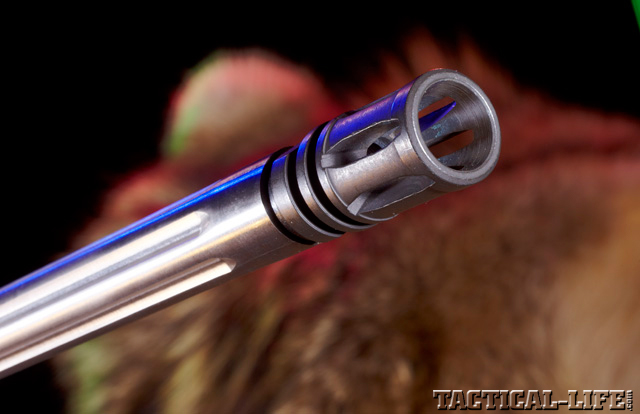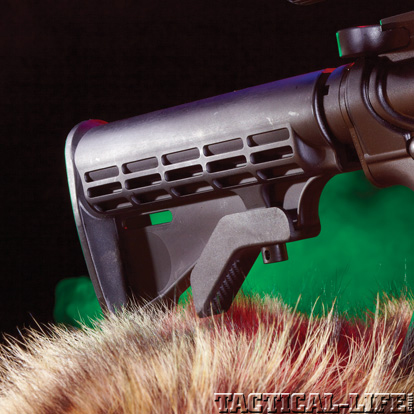When my boys were younger, one of their favorite restaurants was Chuck E. Cheese’s. But they didn’t pick this establishment for the cuisine: it was for the carnival-like atmosphere and the games galore. One of their favorite games was Whac-A-Mole: you take a mallet and, when a mole pops out of its hole, smack it on the head. I joined in now and then, and it was worth some laughs but has never compared to the fun of taking a Alexander Arms .17 HMR semi-auto and whacking ground squirrels as they popped out of their holes, which is exactly what I did in an Eastern Oregon alfalfa field last summer.
One of my favorite activities is to help the local ranchers thin their hay-munching “sage rat” populations, and the Alexander Arms AR-15-platform .17 HMR rifle might just be the best rifle for the job. I dutifully followed the airline’s ammunition weight restriction of 11 pounds for the flight out and wound up bringing nearly 1,400 rounds. When I went home four days later, I had less than 100 rounds left. If it weren’t for alternating between the Alexander Arms .17 and my .223 (different manufacturer), I would have burned up all of my .17 HMR ammo the second day. This Alexander Arms .17 HMR performed flawlessly. The only downtime I had was on the first day, after about 300 rounds—I gave the tiny bore a quick scrub. Nightly cleaning kept the .17 HMR running smoothly and accurately throughout the hunt.
I’m no stranger to cleaning an Alexander Arms .17 HMR. Going back almost two years, I had the honor of receiving the first pre-production rifle from company-owner Bill Alexander. Writing about the rifle wasn’t my only initial task: Alexander wanted me to wring out the rifle to the point of failure.
Advertisement — Continue Reading Below
After discussing .17 calibers with Alexander, my eyes were opened to several things related to this cartridge and the guns that shoot them. He has a well-established reputation for building AR rifles in .50 Beowulf and 6.5 Grendel, but I found out why he chose to chamber the Alexander Arms .17 HMR in a new rimfire cartridge. “When you design rifles you go from peaks to bloody lows,” said Alexander, in his native British vernacular. “I had just finished the Grendel and started looking at the .22 rimfires. I built my own .22 LR AR. When I shot at 50 yards and 70 yards, it did very well—but when I shot at 100 yards, the groups went to hell when the round went subsonic. ‘Why not shoot a .17 HMR,’ I asked myself, ‘to extend the range?’ It was the first pick because it had good performance and customers wanted it.”
Since the Alexander Arms .17 HMR was introduced in 2002, a wide range of guns have been chambered for the popular round. The .17 HMR was the first new rimfire cartridge since the ill-fated 5mm Remington launched in 1970. Previously, the last successful rimfire cartridge was the .22 Winchester Magnum Rimfire introduced in 1959.
Hornady’s Sizzler
When Hornady developed the .17 HMR, they worked with riflemakers Ruger and Marlin to seek the fastest rimfire cartridge that could produce accurate reliability and economic manufacturing. Some of their parameters included performance beyond that of the .22 WMR in trajectory and velocity and less susceptibility to wind drift. Similar noise levels were to be maintained, as well as operation at the same case pressure. Frangible bullets that weren’t as susceptible to ricochet were also specified. All of this was packaged in a cartridge that was designed to shoot under 1 MOA or better. A lesser-known requirement was that the cartridge would produce between 23,000 and 29,000 copper units of pressure.
Advertisement — Continue Reading Below
To ensure success, the new cartridge needed to be adaptable to existing rimfire rifle designs, so settling on the .22 WMR case was the best option. In a little more than nine years, the .17 HMR cartridge roared onto the shooting scene. Loaded with Lil’ Gun powder, this diminutive cartridge produces velocities higher than 2,500 fps with 17-grain loads and 2,375 fps for the 20-grain loads. This combination produces a terminal performance that is deadly on ground-squirrel-sized varmints, out to 200 yards on a windless day.
Birth of the .17
At the cartridge’s introduction, Ruger, Marlin, Savage and CZ built bolt actions for the Alexander Arms .17 HMR. A few single shots followed, but then Remington adapted their Model 597 autoloader to the .17 HMR. That’s where the trouble began. The Alexander Arms .17 HMR’s pressure and thin case didn’t adapt well to the Remington 597. First designed to handle a .22 LR, the 597 used a steel bolt in a blowback mechanism—no problems here. But when the .22 WMR design was adapted to .17 HMR, Remington engineers opted for a heavier tungsten-nickel-iron matrix bolt to retard the speed of the blowback mechanism. But tungsten, though heavier than steel, is more brittle. Another problem with tungsten is that it has an inherent variability in specific gravity that makes a final part’s hardness a moving target. It was just a matter time until something went wrong.
By its very nature, rimfire ammunition is rather dirty. We all know that rapid shooting heats up a rifle barrel, too. When combining the two issues within the confines of a Alexander Arms .17 HMR case, it’s to be expected that pressure will spike and the occasional case will fail. When a .17 HMR case ruptures in a Remington 597, catastrophic failure occurs: the hot propellant gases ride the cuts in the titanium bolt and shatter it, which have led to shooter injuries and lawsuits. “The AR is so massively overbuilt that it just keeps on ticking,” Alexander said, “whereas the 597 blows up.”
Advertisement — Continue Reading Below
Remington was quick, issuing a total recall of th eir Model 597s chambered in .17 HMR. Ruger has also stopped making available their 10-22 magnum .17 HMR versions. On the other hand, Volquartsen hasn’t stopped making their TF-17 semi-autos—they must feel that their semi-auto design is built to handle the Alexander Arms .17 HMR without problems.
Now, along comes Alexander Arms with their new AR in .17 HMR.
Torture Time
The Alexander Arms .17 HMR is utterly devastating on smaller pests, and it’s deadly accurate. I’ve shot everything from ground squirrels, to bushy-tailed tree rats, to jack rabbits by the wagon load, and even a couple of coyotes and wild turkeys. What I learned in the process is that game heavier than 12 pounds deserves heavier calibers and cartridges that provide truly reliable, game-killing performance.
Advertisement — Continue Reading Below
To prepare for accuracy testing, I acquired CCI, Hornady, Remington and Winchester .17 HMR ammo. Shooting .17 centerfire rifles taught me that accuracy starts to suffer when the bore gets dirty—as few as 20 shots can warrant a cleaning to keep accuracy optimal. Gumming up a semi-auto action would be rather easy, so I wanted to learn just how many rounds it would take to bring shooting to a halt. If I had a cartridge case fail, I wanted to learn what would happen as well. To say that I abused that first Alexander Arms .17 HMR is an understatement: I ran this rifle hot and kept sending rounds downrange. Eventually, I found out what happens when a case ruptures.
It doesn’t take long to heat up this rifle. On my initial range tests while firing the 17-grain Hornady loads across a chronograph, the first 10 rounds averaged 2,654 fps. The next 10 rounds climbed in velocity to an average of 2,678 fps, and by the time I ran the third magazine full through, it was averaging 2,703 fps. As best I can determine, the chamber acts as a heat sink, and when rounds are chambered, they heat up quickly. When the hammer drops on a heated case, velocities and pressures rise. The rise in pressure is even more pronounced on hot summer days.
The first time I took the Alexander Arms .17 HMR to the range, I put 300 rounds downrange as fast as possible with the five 10-round magazines in hand. Late in the torture test, case heads blew on at least three rounds. I finally caused a full-blown case rupture that lodged a bullet in the barrel. The magazine’s feed lips suffered from the experience, pieces of the magazine also blew into the trigger well, jamming the trigger, and a bullet got stuck in the barrel.
Advertisement — Continue Reading Below
The following day I telephoned the gun’s designer to report my progress in wrecking his new rifle. Always the inquisitive engineer, Alexander suggested that he make a “house call” to inspect the rifle, and bring me another one to wreck in the process—wreck it we did. The day Alexander arrived we went to the range and got the gun to repeat its cartridge failures without any major mishaps. Blown cases had the penchant for bending the ejector bar, but this was fixed on the range with a pair of pliers. After approximately 450 shots without cleaning, case extraction and feeding became so sluggish it was reduced to a single-shot rifle.
Alexander took the lessons learned during our torture test a couple of years ago and continued to refine the rifle’s mechanism. Today’s Alexander Arms .17 HMR comes off the assembly line with an upgraded extractor and ejector. The success of the design was apparent when I put the rifle through a similar torture test on sage rats. If you follow Alexander’s recommendations and clean the rifle after every 200 shots, it will perform extremely well. Or, if you’re like me, and wait to clean it after six or seven 50-round boxes, it will cycle and shoot almost as well. I cheated a little on my recent hunt, keeping a bottle of CLP handy to slop on the bolt so I could keep shooting.
I don’t need much of an excuse to put rounds downrange with this rifle. I fed the rifle a good supply of several bullet weights from as many ammo manufacturers as I could find. I heard a rumor that Winchester had improved their loads, so I wanted to compare it with the others. To conduct testing, I mounted a Zeiss Conquest 6.5-20×50 scope in a set of Warne rings to get a good look at 100-yard targets. Five-shot groups provide more-reliable data, so I fired 10 rounds of each load across an Oehler 35P chronograph, to check velocities. The accuracy and velocity data represents a compilation of range sessions with temperatures ranging from 92 to 98 degrees. Velocity data had ranged widely between cold- and hot-barrel conditions, with as much as an 80-fps shift in velocity for the same load once the barrel got hot.
Advertisement — Continue Reading Below
The new 15.5- and 17-grain Winchester loads performed quite well, and the best groups were better than the smallest groups produced by the circa-2010 loads. Oddly enough, the 15.5-grain loads averaged 2,449 fps, which is the opposite of what I would expect from a lighter-weight bullet. When I switched over to 20-grain Winchester loads, which were manufactured in 2010, average velocity was 2,101 fps. Hornady’s .17 HMR loads are good performers in this rifle, too.
The Roundup
The .17 HMR is a hot cartridge that’s a lot of fun. Wrap an Alexander Arms AR around it and you’ll have a rugged tack driver that will handle anything the cartridge is cable of tackling. (alexanderarms.com; 540-639-8356)































